Experiencing high CPU usage can make your computer sluggish and unresponsive. It’s a common issue that many users face, often leading to frustration and decreased productivity. Knowing how to diagnose and resolve high CPU usage is crucial for maintaining a smooth and efficient system. This article provides comprehensive steps to fix high CPU usage and optimize your computer’s performance.
Understanding High CPU Usage
CPU (Central Processing Unit) usage refers to the amount of processing power being used by your computer’s processor. When CPU usage is high, it means that your processor is working near its maximum capacity. This can be caused by a variety of factors such as running too many applications, background processes, or malware. To effectively tackle high CPU usage, it’s important to identify the root cause.
Common Causes of High CPU Usage
- Too many applications running simultaneously
- Background processes and services
- Malware or viruses
- Software bugs
- Insufficient system resources
The following table highlights some of the common causes and their corresponding solutions:
| Cause | Solution |
|---|---|
| Too many applications running | Close unnecessary programs |
| Background processes | Disable or manage startup processes |
| Malware or viruses | Run a full system antivirus scan |
| Software bugs | Update or reinstall software |
| Insufficient system resources | Upgrade hardware components |
Step-by-Step Guide to Fix High CPU Usage
Now that we’ve identified the common causes of high CPU usage, let’s delve into the specific steps you can take to fix it:
1. Identify Resource-Intensive Programs
The first step in troubleshooting high CPU usage is to identify which programs or processes are consuming most of the CPU resources. Use the Task Manager in Windows or Activity Monitor in macOS to analyze CPU usage:
- Windows: Press Ctrl + Shift + Esc to open Task Manager. Click on the “Processes” tab and sort by “CPU” to see the most resource-intensive programs.
- macOS: Press Cmd + Space and type “Activity Monitor” to open it. Click on the “CPU” tab to sort processes by CPU usage.
2. Close Unnecessary Applications
Once you’ve identified the resource-hogging programs, close any unnecessary applications. This can free up valuable CPU resources:
- Right-click on the application name in Task Manager or Activity Monitor and select “End Task” or “Quit”
3. Disable Background Processes
Many background processes and services start automatically when your computer boots up. Disabling these can significantly reduce CPU usage:
Windows:
- Press Win + R, type msconfig, and hit Enter
- Go to the “Startup” tab and uncheck programs that you don’t need at startup
macOS:
- Go to “System Preferences” > “Users & Groups”
- Click on your user account and select the “Login Items” tab
- Select the programs you want to disable and click the “-” button
4. Run an Antivirus Scan
Malware and viruses can cause high CPU usage by running malicious processes in the background. Running a full system antivirus scan can help eliminate these threats:
- Ensure your antivirus software is up to date
- Run a full system scan and follow the software’s recommendations to remove any detected threats
5. Update or Reinstall Software
Software bugs can also lead to high CPU usage. Keeping your software up to date or reinstalling problematic applications can resolve these issues:
- Check for updates through the application’s settings or preferences menu
- If issues persist, uninstall the software and reinstall the latest version
6. Upgrade Hardware Components
If your system consistently struggles with high CPU usage, it might be time to upgrade your hardware. Consider the following upgrades:
- Increase RAM: More RAM can help your computer handle more tasks simultaneously
- Upgrade the CPU: A more powerful processor can provide better performance for demanding applications
Conclusion
High CPU usage can be a major hindrance to your computer’s performance, but with the right approach, it’s an issue that can be resolved. By identifying the root cause and applying the appropriate fixes – whether it’s closing unnecessary applications, managing startup processes, running antivirus scans, updating software, or upgrading hardware – you can significantly optimize your system’s performance. Staying proactive in managing your computer’s resources will ensure a smooth and efficient computing experience.

